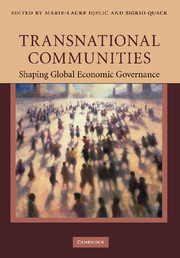Book contents
- Frontmatter
- Contents
- List of figures
- List of tables
- List of appendices
- Contributors
- Preface
- Part I Introduction
- Part II Classical communities with a transnational extension
- Part III Professional communities with a transnational extension
- 5 Transnational boards and governance regimes: a Franco-British comparison
- 6 Private equity in Japan: global financial markets and transnational communities
- 7 Formal organizing and transnational communities: evidence from global finance governance associations, 1879–2006
- 8 Promoting transnational professionalism: forays of the “Big Firm” accounting community into France
- Part IV Virtual communities
- Part V Transnational interest- or issue-based communities
- Part VI Conclusion
- Index
- References
5 - Transnational boards and governance regimes: a Franco-British comparison
Published online by Cambridge University Press: 07 September 2010
- Frontmatter
- Contents
- List of figures
- List of tables
- List of appendices
- Contributors
- Preface
- Part I Introduction
- Part II Classical communities with a transnational extension
- Part III Professional communities with a transnational extension
- 5 Transnational boards and governance regimes: a Franco-British comparison
- 6 Private equity in Japan: global financial markets and transnational communities
- 7 Formal organizing and transnational communities: evidence from global finance governance associations, 1879–2006
- 8 Promoting transnational professionalism: forays of the “Big Firm” accounting community into France
- Part IV Virtual communities
- Part V Transnational interest- or issue-based communities
- Part VI Conclusion
- Index
- References
Summary
Introduction
This chapter assesses the argument that a transnational community of elite corporate directors, bonded by shared values and assumptions, and spanning leading international companies, is emerging as a consequence of globalization and the harmonization of corporate governance practices. Governance regimes are inextricably connected to the interplay between national business systems and the processes, albeit nascent, of transnational community-building. The past decade has witnessed extraordinary global change, fuelled by heightened competition, and marked by extensive transnational corporate restructuring.
Internationalization has raised questions concerning the extent to which best practice in governance regimes may be transported from one national business system to another (Djelic 1998; Whitley 1999). This has generated much research on the prospects for international convergence (Pedersen and Thomsen 1997; Rhodes and van Apeldoorn 1998; Carati and Tourani Rad 2000; Aguilera and Jackson 2003; Toms and Wright 2005; Maclean and Harvey 2008), to which the growing internationalization of the boards of leading global companies might be deemed to be contributing (Conyon and Muldoon 2006; Scherer et al. 2006; Staples 2007). Against this supposed trend, however, it can be seen that actors involved in rule-setting at international level often remain embedded in national and local cultures and environments, from which they extend their behaviors and strategies into the global domain (Djelic and Quack 2003a).
A community, from our perspective, is a defined set of individuals with shared values, assumptions and beliefs, whose interests, whether material, aesthetic or ideological, are bound together. Communities bind individuals into a collective whole.
- Type
- Chapter
- Information
- Transnational CommunitiesShaping Global Economic Governance, pp. 107 - 129Publisher: Cambridge University PressPrint publication year: 2010
References
- 12
- Cited by



